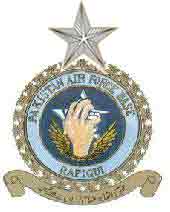|
Soon after the 65 war against India a detailed analysis of the PAF's deficient infrastructure led to the decision to build an alternative main base to Sargodha . Early in 1966 two sites were selected, Jhang and Shorkot, a small village 80 miles northeast of Multan. Jhang was the better site in many respects but the land was too expensive and there was pressure on the PAF not to locate an airfield so close to this historic city. The alternative site, Shorkot was then selected and the runway and essential facilities were completed by 1968.
The name PAF Base Rafiqui was bestowed on Shorkot in honour of the gallant warrior of 1965, Squadron Leader S A Rafiqui - an apt name for a fledgling airfield that would see combat so soon after reaching maturity. The airfield had been a satellite for three years. Rafiqui's first base commander Group Captain Zaheer Hussain took over on 3 September 71; one F-86E and half an F-6 squadron were immediately moved there. At the outset of the war that came three months later, an IAF Su-7 was brought down on the runway by the ack. This was the first time Rafiqui had fired its guns in anger. The choice of building Rafiqui at the Shorkot site proved to be an excellent one; this has been borne out by subsequent events and threat developments as well.
After the war, the operational development of the airfield continued at a brisk pace: fuel storage was increased, armament depots were constructed.Hangars and other maintenance facilities were installed to support the projected combat force. In 1973, some additional operational units were added to the base complement. Rafiqui now houses the several major weapon systems in service in the PAF. A large complex of runways, taxiways and tarmacs bristling with aircraft has come into being. With the mushrooming of supporting facilities, the base population expanded from 1 officer and 26 airmen in 1968 to over 3,000 officers, airmen and civilians by 1985, and more than 5,000 people counting their family members. This gave impetus to the growth of civilian amenities in the small town. A cinema and shopping center were added and a cantonment area demarcated.
The desert around the airfield also began to recede. Thousands of trees and several fruit gardens were planted by successive base commanders, the greatest credit for this going to Group Captain Wiqar Azim. The desert of 1968 has by now been turned into a pleasant surrounding of trees and grass with plentiful recreation and sport facilities. A swimming pool, lawn tennis and badminton courts, and a 9-hole golf course have been built. Sixteen years after its inception as a base, Rafiqui in 1988 is no longer a support airfield. It stands shoulder to shoulder with the frontline bases to share the responsibility for national defence in the central sector.
|

